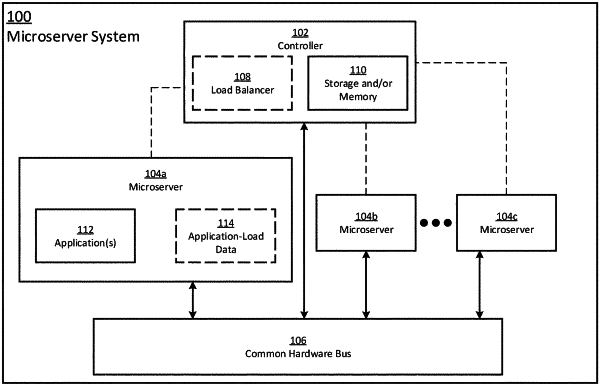| CPC H04L 67/1008 (2013.01) [H04L 43/16 (2013.01)] | 21 Claims |

|
1. A microserver system comprising:
a plurality of microservers;
a controller; and
a common hardware bus physically coupled to and interconnecting the plurality of microservers and the controller, wherein each microserver of the plurality of microservers is configured to execute one or more applications, the controller being configured to:
identify a first group of microservers of the plurality of microservers and a second group of microservers of the plurality of microservers, the second group of microservers being exempt from migration to the first group of microservers;
obtain, via the common hardware bus using load-data access privileges granted to the controller as a result of the controller being physically coupled to the common hardware bus, application-load data associated with the first group of microservers, the application-load data including at least one of current application-load data or historical application-load data and being associated with application data generated by the first group of microservers as a result of executing applications of the one or more applications based on input data received from one or more devices connected to the common hardware bus;
determine, based on the application-load data associated with the one or more applications, a first application load of a first set of one or more applications executed by a first microserver with a smallest application load of the first group of microservers and a second application load of a second set of one or more applications executed by a second microserver of the first group of microservers;
determine that a combination of the first application load and the second application load is below a maximum-application-load threshold of the second microserver; and
migrate, via the common hardware bus using migration privileges granted to the controller as a result of the controller being physically coupled to the common hardware bus, the first set of one or more applications from the first microserver to the second microserver, wherein migrating the first set of one or more applications from the first microserver to the second microserver includes the controller
communicating with the second microserver via the common hardware bus to instantiate the first set of one or more applications on the second microserver,
routing the application data associated with the first set of one more applications to the second microserver via the common hardware bus,
communicating with the first microserver via the common hardware bus to deactivate the first set of one or more applications on the first microserver, and
routing subsequently received input data received from the one or more devices and associated with the first set of one or more applications to the second microserver.
|